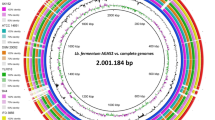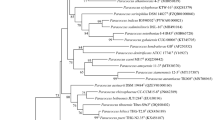Abstract
An Enterobacter strain, WCHECl-C4, was recovered from a human blood sample in China in 2015. Phylogenetic analysis based on multi-locus sequence analysis of the rpoB, gyrB, infB and atpD housekeeping genes revealed that the strain is distinct from any previously described species of the genus Enterobacter. The whole genome sequence of strain WCHECl-C4 has an 80.48–93.34% average nucleotide identity with those of type strains of all known Enterobacter species. In silico DNA–DNA hybridization (isDDH) values between strain WCHECl-C4 and type strains of all known Enterobacter species range from 23.2 to 52.4%. The major cellular fatty acids of strain WCHECl-C4 are C16:0, C17:0 cyclo and C18:1ω7c, which are in the range of Enterobacter species. The genomic DNA G + C content was 55.7 mol%. Strain WCHECl-C4 can be distinguished from all known Enterobacter species by its ability to ferment d-sorbitol, l-rhamnose and melibiose but with a negative Voges–Proskauer reaction. Genotypic and phenotypic characteristics from this study indicate that strain WCHECl-C4 represents a novel species of the genus Enterobacter, for which the name Enterobacter chengduensis sp. nov. is proposed. The type strain is WCHECl-C4T (= GDMCC1.1216T = CCTCC AB 2017105T = KCTC 52993T).



Similar content being viewed by others
References
Alnajar S, Gupta RS (2017) Phylogenomics and comparative genomic studies delineate six main clades within the family Enterobacteriaceae and support the reclassification of several polyphyletic members of the family. Infect Genet Evol 54:108–127
Bankevich A et al (2012) SPAdes: a new genome assembly algorithm and its applications to single-cell sequencing. J Comput Biol 19:455–477
Bolger AM, Lohse M, Usadel B (2014) Trimmomatic: a flexible trimmer for Illumina sequence data. Bioinformatics 30:2114–2120
Brady C, Cleenwerck I, Venter S, Coutinho T, De Vos P (2013) Taxonomic evaluation of the genus Enterobacter based on multilocus sequence analysis (MLSA): proposal to reclassify E. nimipressuralis and E. amnigenus into Lelliottia gen. nov. as Lelliottia nimipressuralis comb. nov. and Lelliottia amnigena comb. nov., respectively, E. gergoviae and E. pyrinus into Pluralibacter gen. nov. as Pluralibacter gergoviae comb. nov. and Pluralibacter pyrinus comb. nov., respectively, E. cowanii, E. radicincitans, E. oryzae and E. arachidis into Kosakonia gen. nov. as Kosakonia cowanii comb. nov., Kosakonia radicincitans comb. nov., Kosakonia oryzae comb. nov. and Kosakonia arachidis comb. nov., respectively, and E. turicensis, E. helveticus and E. pulveris into Cronobacter as Cronobacter zurichensis nom. nov., Cronobacter helveticus comb. nov. and Cronobacter pulveris comb. nov., respectively, and emended description of the genera Enterobacter and Cronobacter. Syst Appl Microbiol 36:309–319
CLSI (2017) Performance standards for antimicrobial susceptibility testing; twenty-seventh informational supplement. M100-S27. Clinical and Laboratory Standards Institute, Wayne
Doijad S et al (2016) Enterobacter bugandensis sp. nov., from neonatal blood. Int J Syst Evol Microbiol 66:968–974
Duan YQ et al (2015) Enterobacter tabaci sp. nov., a novel member of the genus Enterobacter isolated from a tobacco stem. Antonie Van Leeuwenhoek 108:1161–1169
Emms DM, Kelly S (2015) OrthoFinder: solving fundamental biases in whole genome comparisons dramatically improves orthogroup inference accuracy. Genome Biol 16:157
Goris J, Konstantinidis KT, Klappenbach JA, Coenye T, Vandamme P, Tiedje JM (2007) DNA–DNA hybridization values and their relationship to whole-genome sequence similarities. Int J Syst Evol Microbiol 57:81–91
Hu Y, Feng Y, Zhang X, Zong Z (2017) Acinetobacter defluvii sp. nov., recovered from hospital sewage. Int J Syst Evol Microbiol 67:1709–1713
Kämpfer P, Doijad S, Chakraborty T, Glaeser SP et al (2016) The status of the species Enterobacter siamensis Khunthongpan 2014. Request for an Opinion. Int J Syst Evol Microbiol 66:524–525
Katoh K, Standley DM (2013) MAFFT multiple sequence alignment software version 7: improvements in performance and usability. Mol Biol Evol 30:772–780
Khunthongpan S, Bourneow C, H-Kittikun A, Tanasupawat S, Benjakul S, Sumpavapo P (2013) Enterobacter siamensis sp. nov., a transglutaminase-producing bacterium isolated from seafood processing wastewater in Thailand. J Gen Appl Microbiol 59:135–140
Lane D (1991) 16S/23S rRNA sequencing. In: Stackebrandt E, Goodfellow M (eds) Nucleic acid techniques in bacterial systematics. Wiley, Chichester, pp 115–175
Li CY, Zhou YL, Ji J, Gu CT (2016) Reclassification of Enterobacter oryziphilus and Enterobacter oryzendophyticus as Kosakonia oryziphila comb. nov. and Kosakonia oryzendophytica comb. nov. Int J Syst Evol Microbiol 66:2780–2783
Lin J, Zhao F, Feng Y, Zong Z (2017) Draft genome sequence of a high-level colistin-resistant clinical strain of the Enterobacter cloacae Complex. Genome Announc 5:00131
Manter DK, Hunter WJ, Vivanco JM (2011) Enterobacter soli sp. nov.: a lignin-degrading gamma-proteobacteria isolated from soil. Curr Microbiol 62:1044–1049
Meier-Kolthoff JP, Auch AF, Klenk HP, Goker M (2013) Genome sequence-based species delimitation with confidence intervals and improved distance functions. BMC Bioinform 14:60
Mezzatesta ML, Gona F, Stefani S (2012) Enterobacter cloacae complex: clinical impact and emerging antibiotic resistance. Future Microbiol 7:887–902
Naum M, Brown EW, Mason-Gamer RJ (2008) Is 16S rDNA a reliable phylogenetic marker to characterize relationships below the family level in the enterobacteriaceae? J Mol Evol 66:630–642
Qin QL et al (2014) A proposed genus boundary for the prokaryotes based on genomic insights. J Bacteriol 196:2210–2215
Richter M, Rossello-Mora R (2009) Shifting the genomic gold standard for the prokaryotic species definition. Proc Natl Acad Sci USA 106:19126–19131
Richter M, Rossello-Mora R, Oliver Glockner F, Peplies J (2016) JSpeciesWS: a web server for prokaryotic species circumscription based on pairwise genome comparison. Bioinformatics 32:929–931
Seemann T (2014) Prokka: rapid prokaryotic genome annotation. Bioinformatics 30:2068–2069
Stamatakis A (2014) RAxML version 8: a tool for phylogenetic analysis and post-analysis of large phylogenies. Bioinformatics 30:1312–1313
Tidjani Alou M et al (2017) ‘Khelaifiella massiliensis’, ‘Niameybacter massiliensis’, ‘Brachybacterium massiliense’, ‘Enterobacter timonensis’, ‘Massilibacillus massiliensis’, new bacterial species and genera isolated from the gut microbiota of healthy infants. New Microbes New Infect 19:1–7
Acknowledgements
We are grateful to Feifei Zhao and Li Wei at West China Hospital for collecting the isolate. The work was supported by grants from the National Natural Science Foundation of China (Project Nos. 81772233 and 81572030) and a joint grant from the National Natural Science Foundation of China (Project No. 81661130159) and the Newton Advanced Fellowship, Royal Society, UK (NA150363).
Author information
Authors and Affiliations
Contributions
WW performed the phenotype experiments; YF performed genome and phylogenetic analysis; ZZ designed the study, analyzed the data and draft the manuscript.
Corresponding author
Ethics declarations
Conflict of interest
The authors declare that they have no conflict of interest.
Electronic supplementary material
Below is the link to the electronic supplementary material.
Rights and permissions
About this article
Cite this article
Wu, W., Feng, Y. & Zong, Z. Characterization of a strain representing a new Enterobacter species, Enterobacter chengduensis sp. nov.. Antonie van Leeuwenhoek 112, 491–500 (2019). https://doi.org/10.1007/s10482-018-1180-z
Received:
Accepted:
Published:
Issue Date:
DOI: https://doi.org/10.1007/s10482-018-1180-z




